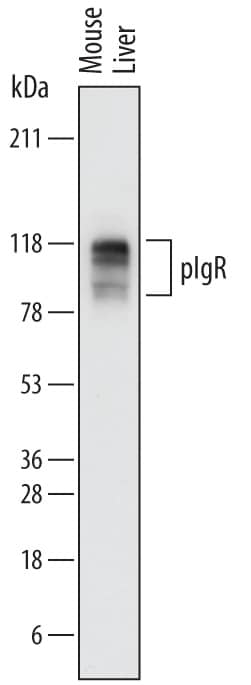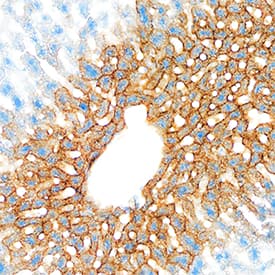Mouse pIgR Antibody
R&D Systems, part of Bio-Techne | Catalog # AF2800


Key Product Details
Species Reactivity
Validated:
Cited:
Applications
Validated:
Cited:
Label
Antibody Source
Product Specifications
Immunogen
Lys19-Lys645
Accession # O70570
Specificity
Clonality
Host
Isotype
Endotoxin Level
Scientific Data Images for Mouse pIgR Antibody
Detection of Mouse pIgR by Western Blot.
Western blot shows lysates of mouse liver tissue. PVDF membrane was probed with 0.2 µg/mL of Goat Anti-Mouse pIgR Antigen Affinity-purified Polyclonal Antibody (Catalog # AF2800) followed by HRP-conjugated Anti-Goat IgG Secondary Antibody (Catalog # HAF017). Specific bands were detected for pIgR at approximately 85 to 115 kDa (as indicated). This experiment was conducted under reducing conditions and using Immunoblot Buffer Group 1.pIgR in Mouse Liver.
pIgR was detected in immersion fixed frozen sections of mouse liver using Goat Anti-Mouse pIgR Antigen Affinity-purified Polyclonal Antibody (Catalog # AF2800) at 1 µg/mL overnight at 4 °C. Tissue was stained using the Anti-Goat HRP-DAB Cell & Tissue Staining Kit (brown; Catalog # CTS008) and counterstained with hematoxylin (blue). Specific staining was localized to hepatocyte cytoplasm and plasma membrane. View our protocol for Chromogenic IHC Staining of Frozen Tissue Sections.Applications for Mouse pIgR Antibody
Blockade of Receptor-ligand Interaction
Immunohistochemistry
Sample: Perfusion fixed frozen sections of mouse intestine, kidney, and liver
Western Blot
Sample: Mouse liver tissue
Reviewed Applications
Read 1 review rated 3 using AF2800 in the following applications:
Formulation, Preparation, and Storage
Purification
Reconstitution
Formulation
Shipping
Stability & Storage
- 12 months from date of receipt, -20 to -70 °C as supplied.
- 1 month, 2 to 8 °C under sterile conditions after reconstitution.
- 6 months, -20 to -70 °C under sterile conditions after reconstitution.
Background: pIgR
The mouse polymeric immunoglobulin receptor (plgR; also known as membrane secretory component) is a 115 kDa type I transmembrane glycoprotein that is synthesized as a 771 amino acid (aa) precursor. It includes an 18 aa signal sequence, a 627 aa extracellular domain (ECD) (aa 19‑645), a 23 aa transmembrane segment (aa 646‑668), and a 143 aa cytoplasmic region (aa 669‑771) (1‑3). The ECD consists of five V-type Ig-like domains and a sixth non-Ig domain that connects to the transmembrane region. The ECD of mouse plgR is 65%, 69%, 85%, 62% and 62% aa identical to the equivalent region in human, porcine, rat, bovine and canine, respectively. plgR is expressed on secretory epithelial cells and serves as a carrier that transports IgA and IgM across epithelium (1, 2, 4). On the basolateral surface of epithelial cells, the receptor initially binds non-covalently to IgA via domains #1 and #5 of the plgR. A rearrangement then occurs where a disulfide bond forms between domain #5 of the plgR and an IgA heavy chain (2). This complex is then internalized and transcytosed to the apical surface. A soluble covalent complex called secretory IgA (SIgA) is generated by proteolytic cleavage of the complex in the sixth extracellular domain of plgR and released into the lumen (5). This proteolytically generated plgR fragment is referred to as secretory component (SC). Notably, in human, plgR transcytoses constitutively, with or without ligand, creating both a bound and free, 78 kDa SC following cleavage (3). In mouse, this event would be expected to generate a 95 kDa fragment (1). The receptor component of the complex anchors the SIgA molecule to mucous (6), where it serves to protect mucous membranes that form a barrier between the interior of the body and the external environment (7).
References
- de Groot, N. et al. (1999) Transgenic Res. 8:125.
- Piskurich, J. et al. (1995) J. Immunol. 154:1735.
- Brandtzaeg, P. and F-E. Johansen (2001) Trends Immunol. 22:545.
- Ben-Hur, H. et al. (2004) Int. J. Mol. Med. 14:35.
- Asano, M. et al. (2004) Immunology 112:583.
- Phalipon, A. and B. Corthesy (2003) Trends Immunol. 24:55.
- Uren, T. et al. (2003) J. Immunol. 170:2531.
Long Name
Alternate Names
Gene Symbol
UniProt
Additional pIgR Products
Product Documents for Mouse pIgR Antibody
Product Specific Notices for Mouse pIgR Antibody
For research use only
